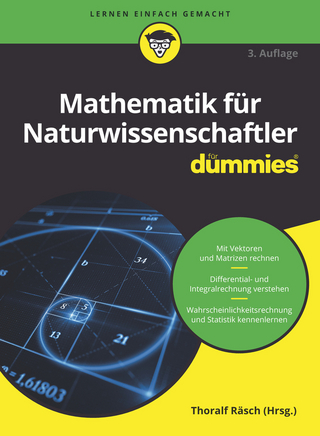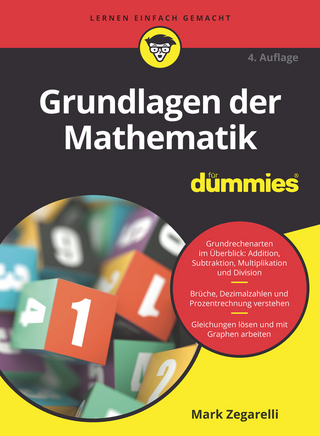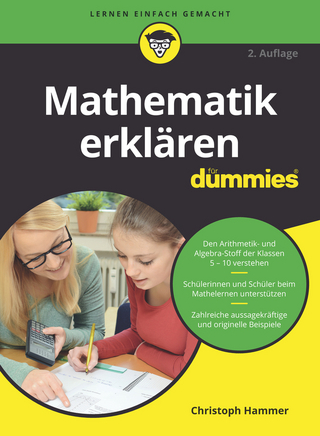
Mathematical Meditations
Taylor & Francis Ltd (Verlag)
978-1-032-24907-0 (ISBN)
- Noch nicht erschienen (ca. Februar 2025)
- Versandkostenfrei innerhalb Deutschlands
- Auch auf Rechnung
- Verfügbarkeit in der Filiale vor Ort prüfen
- Artikel merken
The Meditations in this book are the product of thousands of years of mathematical discourse. As you read through the book and work through the various exercises, you will discover new mechanisms that allow you to contemplate and understand some complex mathematical principles. However, the focus will always be wider than a mere dry comprehension of theory, as you will be encouraged to meditate upon the deeper intrinsic beauty of mathematics and what it can reveal to us about the world around us.
Features
An original, engaging narrative format replete with novel exercises and examples
Could be used in a classroom setting for liberal arts students, mathematics undergraduates, or for high school teachers
Accessible to anyone who wants to explore a different kind of perspective on mathematics.
Snezana Lawrence is a mathematical historian and mathematics educator, and has been working in higher education for the past 15 years. Prior to that, Snezana was a teacher and teacher trainer in the English school-system. She was a lead consultant for the Prince’s Teaching Institute for Mathematics 2009-2018. Currently Snezana works as a Senior Lecturer in the Department of Mathematics and Design Engineering at Middlesex University, London, teaching mathematics, mathematics history, and risk. Snezana’s plan for the next few years it to write more popular history of mathematics books and to work more with teachers and people interested in identifying their local history of mathematics in libraries and museums where they live, across Europe. She was the Chair of the History and Pedagogy of Mathematics International Study Group for 2020-2024.
1. Labyrinth: From Minotaur to Chartres. The Cretan labyrinth. The Labyrinth of the Notre Dame de Chartres. Further exploration. 2. Pathways and bridges. The famous seven bridges. Further doodling with pathways. The Inspector General. Closing of the pathways with Hamilton. Further exploration. 3. Diagrams to contemplate upon. The right angled triangle with an inscribed square. The mean proportional. Now for the circles. Signs by the roadside on a Shintu pilgrimage. Little meditative question from Dyson. Further reading. 4. Music for your mind. Bach, the art of fugue, and group theory. Our tool set – group theory. Applying group theory to music. The musical clock. Further exploration. 5. Friendships: mathematicians and musicians. Gersonides and the free will question. Further exploration. 6. Presence and transience. Crome or Chrome, Huxley’s Yellow. Sketching with the chrome yellow. The numbers that keep coming up. Further exploration. 7. Prussian blue and the blue waves. The Wave and the fractals. A group of mathematicians of order three. What does B in Benoit B Mandelbroth stand for?. Fractal making. The ideal library. Further exploration. 8. Que sera, sera (what will be will be). The Dreams and Dreamers. Harmony of the world. Beautiful solids. Further exploration. 9. Questions and Answers. Goldbach conjecture. Twin prime conjecture. 196 algorithm. Is 10 a solitary number?. Further investigations. 10. The Centre of Action. It is elementary, my dear Miss Watson. A few other circles. The excircles. Some points on (all) circles. Further explorations. 11. Mathematical objects. Arithmetica by Diophantus. Hilbert’s Hotel. Möbius Band. Piero della Francesca’s master-piece?. Further reading. 12. Tracing the movement. Imagine a trace you leave behind. Hyperbolas and ellipses in motion. Dandelin’s ice-cream. Further explorations. Instead of chapter 13. Mathematicians mentioned (in alphabetical order). Alicia Boole Stott (1860-1940). Viggo Brun (1885-1978). Germinal Dandelin (1794-1847). Diophantus (date of birth unknown? – 284 AD). Freeman Dyson (1923-2020). Euclid. Leonhard Euler (1707-1783). Pierre Fatou (1878 – 1928). Pierre de Fermat (1601-1665). Karl Wilhelm Feuerbach (1800-1834). Rene Maurice Fréchet (1878-1973). Gersonides (1288-1344). Christian Goldbach (1690-1764). Alexander Grothendieck (1928-2014). William Rowan Hamilton (1805-1865). David Hilbert (1862-1943). Hypatia (c.350-415). Iamblichus (c. 245-c.325). Gaston Julia (1893-1978). Fuijita Sadasuke Kagen (1734-1807). Johannes Kepler (1571-1630). Felix Christian Klein (1849-1925). Gottfried Wilhelm Leibniz (1646-1716). Paul Pierre Lévy (1886-1971). Benoit B. Mandelbrot (1924-2010). Marin Mersenne (1588-1648). August Ferdinand Möbius (1790-1868). Gaspard Monge (1746-1818). Nicomachus (c.60-c. 120). Nicole Oresme (1325-1382). Blaise Pascal (1623-1662). Louis Poinsot (1777-1859). Pythagoras of Samos (c. 570 BCE – c. 495 BCE). Bertrand Russell (later Lord Russell, 3rd Earl Russell, 1872-1970). Theon of Smyrna (flourished around 100). Ernst Zermelo (1871-1953). Post-scriptum and all that.
| Erscheint lt. Verlag | 24.2.2025 |
|---|---|
| Reihe/Serie | AK Peters/CRC Recreational Mathematics Series |
| Zusatzinfo | 8 Line drawings, color; 162 Line drawings, black and white; 8 Illustrations, color; 162 Illustrations, black and white |
| Verlagsort | London |
| Sprache | englisch |
| Maße | 156 x 234 mm |
| Themenwelt | Mathematik / Informatik ► Mathematik ► Allgemeines / Lexika |
| Mathematik / Informatik ► Mathematik ► Angewandte Mathematik | |
| ISBN-10 | 1-032-24907-2 / 1032249072 |
| ISBN-13 | 978-1-032-24907-0 / 9781032249070 |
| Zustand | Neuware |
| Haben Sie eine Frage zum Produkt? |
aus dem Bereich


